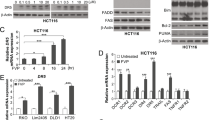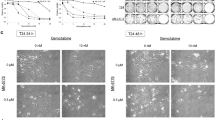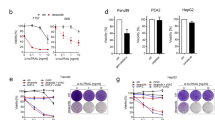Abstract
The broad-range cyclin-dependent kinase inhibitor 7-hydroxystaurosporine (UCN-01) is known to induce both a G1 cell cycle arrest and apoptosis. The mechanism of UCN-01-induced apoptosis is largely unknown. We analysed the mechanism of cytotoxicity of UCN-01 in four established colon carcinoma cell lines. The cell lines SW48 and LS513 responded to UCN-01 treatment by undergoing apoptosis in a concentration-dependent manner while the cell lines HT-29 and WiDr were completely resistant. Apoptosis in LS513 and SW48 cell lines was concomitant with the suppression of Bcl-xL on mRNA and protein level. In contrast, in the apoptosis-resistant cell lines, Bcl-xL expression was not affected by UCN-01. Stable overexpression of the Bcl-xL protein abrogated UCN-01-triggered apoptosis, but only partially restored growth, indicating that both cell cycle arrest and apoptosis exert the anticancer effect in a coordinated manner. The inhibition of Akt phosphorylation did not correlate with the apoptotic phenotype. UCN-01 inhibited the activating STAT3 phosphorylations on Ser727 and, notably, on Tyr705, but STAT3 did not contribute to Bcl-xL expression in colon carcinoma cells. Moreover, we show for the first time that UCN-01 induces apoptosis by suppression of Bcl-xL expression. The inhibition of this pathway is a new aspect of cytotoxic and modulatory potential of UCN-01.
This is a preview of subscription content, access via your institution
Access options
Subscribe to this journal
Receive 50 print issues and online access
$259.00 per year
only $5.18 per issue
Buy this article
- Purchase on Springer Link
- Instant access to full article PDF
Prices may be subject to local taxes which are calculated during checkout









Similar content being viewed by others
Abbreviations
- p53wt:
-
p53 wild type
- p53mut:
-
p53 mutated
References
Abe S, Kubota T, Otani Y, Furukawa T, Watanabe M, Kumai K and Kitajima M . (2000). Jpn. J. Cancer Res., 91, 1192–1198.
Ahn J, Urist M and Prives C . (2003). J. Biol. Chem., 278, 20480–20489.
Akinaga S, Gomi K, Morimoto M, Tamaoki T and Okabe M . (1991). Cancer Res., 51, 4888–4892.
Akinaga S, Nomura K, Gomi K and Okabe M . (1993). Cancer Chemother. Pharmacol., 32, 183–189.
Akinaga S, Sugiyama K and Akiyama T . (2000). Anticancer Drug Des., 15, 43–52.
Akiyama T, Shimizu M, Okabe M, Tamaoki T and Akinaga S . (1999a). Anticancer Drugs, 10, 67–78.
Akiyama T, Sugiyama K, Shimizu M, Tamaoki T and Akinaga S . (1999b). Jpn. J. Cancer Res., 90, 1364–1372.
Alas S and Bonavida B . (2003). Clin. Cancer Res., 9, 316–326.
Amundson SA, Myers TG, Scudiero D, Kitada S, Reed JC, Fornace AJ and Jr . (2000). Cancer Res., 60, 6101–6110.
Bredel M, Pollack IF, Freund JM, Rusnak J and Lazo JS . (1999). J. Neurooncol., 41, 9–20.
Bunch RT and Eastman A . (1996). Clin. Cancer Res., 2, 791–797.
Burke WM, Jin X, Lin HJ, Huang M, Liu R, Reynolds RK and Lin J . (2001). Oncogene, 20, 7925–7934.
Byrd JC, Shinn C, Willis CR, Flinn IW, Lehman T, Sausville E, Lucas D and Grever MR . (2001). Exp. Hematol., 29, 703–708.
Catlett-Falcone R, Landowski TH, Oshiro MM, Turkson J, Levitzki A, Savino R, Ciliberto G, Moscinski L, Fernandez-Luna JL, Nunez G, Dalton WS and Jove R . (1999). Immunity, 10, 105–115.
Chan UP, Lee JF, Wang SH, Leung KL and Chen GG . (2003). Anticancer Drugs, 14, 761–766.
Chen C, Edelstein LC and Gelinas C . (2000). Mol. Cell. Biol., 20, 2687–2695.
Cosset FL, Takeuchi Y, Battini JL, Weiss RA and Collins MK . (1995). J. Virol., 69, 7430–7436.
Dai Y, Yu C, Singh V, Tang L, Wang Z, McInistry R, Dent P and Grant S . (2001). Cancer Res., 61, 5106–5115.
Daniel PT, Schulze-Osthoff K, Belka C and Güner D . (2003). Essays Biochem., 39, 73–88.
Fan S, Chang JK, Smith ML, Duba D, Fornace AJJ and O'Connor PM . (1997). Oncogene, 14, 2127–2136.
Gillissen B, Essmann F, Graupner V, Stärck L, Radetzki S, Dörken B, Schulze-Osthoff K and Daniel PT . (2003). EMBO J., 22, 3580–3590.
Grad JM, Zeng XR and Boise LH . (2000). Curr. Opin. Oncol., 12, 543–549.
Hanski C, Stolze B and Riecken EO . (1992). Int. J. Cancer, 50, 924–929.
Hirose Y, Berger MS and Pieper RO . (2001). Cancer Res., 61, 5843–5849.
Husain A, Yan XJ, Rosales N, Aghajanian C, Schwartz GK and Spriggs DR . (1997). Clin. Cancer Res., 3, 2089–2097.
Kato K, Nomoto M, Izumi H, Ise T, Nakano S, Niho Y and Kohno K . (2000). Biochim. Biophys. Acta, 1493, 91–100.
Kawakami K, Futami H, Takahara J and Yamaguchi K . (1996). Biochem. Biophys. Res. Commun., 219, 778–783.
Koh J, Kubota T, Migita T, Abe S, Hashimoto M, Hosoda Y and Kitajima M . (2002). Breast Cancer, 9, 50–54.
Kruger EA, Blagosklonny MV, Dixon SC and Figg WD . (1998). Invas. Metast., 18, 209–218.
Lee HH, Dadgostar H, Cheng Q, Shu J and Cheng G . (1999). Proc. Natl. Acad. Sci. USA, 96, 9136–9141.
Leong PL, Andrews GA, Johnson DE, Dyer KF, Xi S, Mai JC, Robbins PD, Gadiparthi S, Burke NA, Watkins SF and Grandis JR . (2003). Proc. Natl. Acad. Sci. USA, 100, 4138–4143.
Mack PC, Gandara DR, Bowen C, Edelman MJ, Paglieroni T, Schnier JB, Gelmann EP and Gumerlock PH . (1999). Clin. Cancer Res., 5, 2596–2604.
Mora LB, Buettner R, Seigne J, Diaz J, Ahmad N, Garcia R, Bowman T, Falcone R, Fairclough R, Cantor A, Muro-Cacho C, Livingston S, Karras J, Pow-Sang J and Jove R . (2002). Cancer Res., 62, 6659–6666.
Nieves-Neira W and Pommier Y . (1999). Int. J. Cancer, 82, 396–404.
O'Connor PM and Fan S . (1996). Prog. Cell Cycle Res., 2, 165–173.
Patel V, Lahusen T, Leethanakul C, Igishi T, Kremer M, Quintanilla-Martinez L, Ensley JF, Sausville EA, Gutkind JS and Senderowicz AM . (2002). Clin. Cancer Res., 8, 3549–3560.
Plowright EE, Li Z, Bergsagel PL, Chesi M, Barber DL, Branch DR, Hawley RG and Stewart AK . (2000). Blood, 95, 992–998.
Powell SN, DeFrank JS, Connell P, Eogan M, Preffer F, Dombkowski D, Tang W and Friend S . (1995). Cancer Res., 55, 1643–1648.
Sato S, Fujita N and Tsuruo T . (2002). Oncogene, 21, 1727–1738.
Seynaeve CM, Stetler-Stevenson M, Sebers S, Kaur G, Sausville EA and Worland PJ . (1993). Cancer Res., 53, 2081–2086.
Shao RG, Shimizu T and Pommier Y . (1997). Exp. Cell Res., 234, 388–397.
Sugiyama K, Akiyama T, Shimizu M, Tamaoki T, Courage C, Gescher A and Akinaga S . (1999). Cancer Res., 59, 4406–4412.
Takahashi I, Kobayashi E, Asano K, Yoshida M and Nakano H . (1987). J. Antibiot. (Tokyo), 40, 1782–1784.
Usuda J, Saijo N, Fukuoka K, Fukumoto H, Kuh HJ, Nakamura T, Koh Y, Suzuki T, Koizumi F, Tamura T, Kato H and Nishio K . (2000). Int. J. Cancer, 85, 275–280.
von Haefen C, Wieder T, Essmann F, Schulze-Osthoff K, Dorken B and Daniel PT . (2003). Oncogene, 22, 2236–2247.
von Haefen C, Wieder T, Gillissen B, Starck L, Graupner V, Dorken B and Daniel PT . (2002). Oncogene, 21, 4009–4019.
Wang Q, Fan S, Eastman A, Worland PJ, Sausville EA and O'Connor PM . (1996). J. Natl. Cancer Inst., 88, 956–965.
Wang Q, Worland PJ, Clark JL, Carlson BA and Sausville EA . (1995). Cell Growth Differ., 6, 927–936.
Wei LH, Kuo ML, Chen CA, Chou CH, Lai KB, Lee CN and Hsieh CY . (2003). Oncogene, 22, 1517–1527.
Yamit-Hezi A, Nir S, Wolstein O and Dikstein R . (2000). J Biol Chem, 275, 18180–18187.
Yu Q, La Rose J, Zhang H, Takemura H, Kohn KW and Pommier Y . (2002). Cancer Res., 62, 5743–5748.
Acknowledgements
The excellent technical assistance of Britta Jebautzke is acknowledged. Mandar Bhonde and Roberta Magrini were supported by the Sonnenfeld-Stiftung.
Author information
Authors and Affiliations
Corresponding author
Rights and permissions
About this article
Cite this article
Bhonde, M., Hanski, ML., Magrini, R. et al. The broad-range cyclin-dependent kinase inhibitor UCN-01 induces apoptosis in colon carcinoma cells through transcriptional suppression of the Bcl-xL protein. Oncogene 24, 148–156 (2005). https://doi.org/10.1038/sj.onc.1207842
Received:
Revised:
Accepted:
Published:
Issue Date:
DOI: https://doi.org/10.1038/sj.onc.1207842
Keywords
This article is cited by
-
Caspase-9 mediates Puma activation in UCN-01-induced apoptosis
Cell Death & Disease (2014)
-
UCN-01 induces S and G2/M cell cycle arrest through the p53/p21waf1or CHK2/CDC25C pathways and can suppress invasion in human hepatoma cell lines
BMC Cancer (2013)
-
Equivalent effect of DNA damage-induced apoptotic cell death or long-term cell cycle arrest on colon carcinoma cell proliferation and tumour growth
Oncogene (2006)
-
Induction of p21CIP/WAF-1 and G2 arrest by ionizing irradiation impedes caspase-3-mediated apoptosis in human carcinoma cells
Oncogene (2006)



